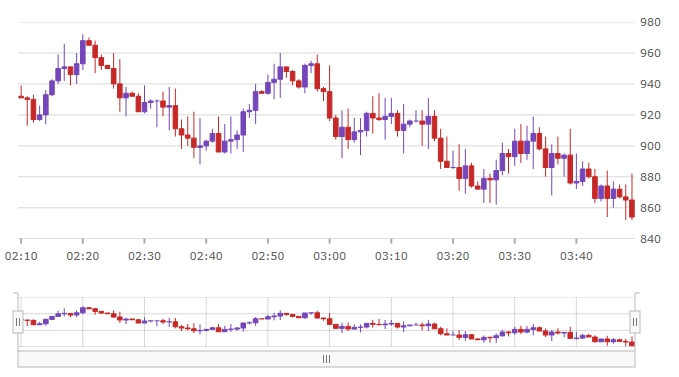xmlns:ig="http://schemas.infragistics.com/xaml"This topic demonstrates how to bind data to the XamFinancialChart control. At the end of each section, a complete code sample is provided.
This topic contains the following sections:
The procedure below demonstrates how to bind the XamFinancialChart control to live data. The XamFinancialChart allows you to bind to any object that implements the IEnumerable interface. Nested collections that implement ICollection and IEnumerable are also supported.
The ChartType property enables you to choose which series type you wish to display.
Supported series types:
Bar
Candle
Column
Line
Following are the general requirements for adding the XamFinancialChart control.
Add the following NuGet package reference to your application:
Infragistics.WPF.FinancialChart
For more information on setting up the NuGet feed and adding NuGet packages, you can take a look at the following documentation: NuGet Feeds.
In XAML:
xmlns:ig="http://schemas.infragistics.com/xaml"In C#:
using Infragistics.Controls.Charts;In VB:
Imports Infragistics.Controls.ChartsThe XamFinancialChart control as implemented by the binding to data sample code:

Defining a Data Model
Adding an Instance of the XamFinancialChart control
(Optional) Verifying the result
Define Data
Create a class to model the data:
When the ItemsSource implements INotifyCollectionChanged, the chart will respond to the CollectionChanged events.
Also as long as the objects in the ItemsSource implement INotifyPropertyChanged, the chart will respond to the PropertyChanged events.
In C#:
public class Price : ObservableModel
{
private DateTime _time;
private double _open;
private double _high;
private double _low;
private double _close;
private double _volume;
public DateTime Time
{
get { return _time; }
set
{
if (_time != value)
{
_time = value;
OnPropertyChanged();
}
}
}
public double Open
{
get { return _open; }
set
{
if (_open != value)
{
_open = value;
OnPropertyChanged();
}
}
}
public double High
{
get { return _high; }
set
{
if (_high != value)
{
_high = value;
OnPropertyChanged();
}
}
}
public double Low
{
get { return _low; }
set
{
if (_low != value)
{
_low = value;
OnPropertyChanged();
}
}
}
public double Close
{
get { return _close; }
set
{
if (_close != value)
{
_close = value;
OnPropertyChanged();
}
}
}
public double Volume
{
get { return _volume; }
set
{
if (_volume != value)
{
_volume = value;
OnPropertyChanged();
}
}
}
public string Label { get { return this.Time.ToShortDateString(); } }
}
public class ObservableModel : INotifyPropertyChanged
{
public event PropertyChangedEventHandler PropertyChanged;
public void OnPropertyChanged([CallerMemberName] String propertyName = "")
{
if (PropertyChanged != null)
{
PropertyChanged(this, new PropertyChangedEventArgs(propertyName));
}
}
}In Visual Basic:
Public Class Price
Inherits ObservableModel
Private _time As DateTime
Private _open As Double
Private _high As Double
Private _low As Double
Private _close As Double
Private _volume As Double
Public Property Time As DateTime
Get
Return Me._time
End Get
Set
If (Me._time <> value) Then
Me._time = value
OnPropertyChanged
End If
End Set
End Property
Public Property Open As Double
Get
Return Me._open
End Get
Set
If (Me._open <> value) Then
Me._open = value
OnPropertyChanged
End If
End Set
End Property
Public Property High As Double
Get
Return Me._high
End Get
Set
If (Me._high <> value) Then
Me._high = value
OnPropertyChanged
End If
End Set
End Property
Public Property Low As Double
Get
Return Me._low
End Get
Set
If (Me._low <> value) Then
Me._low = value
OnPropertyChanged
End If
End Set
End Property
Public Property Close As Double
Get
Return Me._close
End Get
Set
If (Me._close <> value) Then
Me._close = value
OnPropertyChanged
End If
End Set
End Property
Public Property Volume As Double
Get
Return Me._volume
End Get
Set
If (Me._volume <> value) Then
Me._volume = value
OnPropertyChanged
End If
End Set
End Property
Public ReadOnly Property Label As String
Get
Return Me.Time.ToShortDateString
End Get
End Property
End Class
Public Class ObservableModel
Implements INotifyPropertyChanged
Public Event PropertyChanged As PropertyChangedEventHandler
Public Sub OnPropertyChanged(Optional ByVal propertyName As String = "")
If (Not (PropertyChanged) Is Nothing) Then
PropertyChanged(Me, New PropertyChangedEventArgs(propertyName))
End If
End Sub
End ClassAdd an instance of the XamFinancialChart Control
Add an instance of the XamFinancialChart and bind it to the data:
In XAML:
<Window.DataContext>
<local:Data />
</Window.DataContext>
<Grid>
<ig:XamFinancialChart ItemsSource="{Binding}" />
</Grid>Finally you will want to update your data source with the new data you pull from your service.
(Optional) Verify the Result
Run your application to verify the result. If you have successfully bound the XamFinancialChart control to the data collection, the resulting chart will look like the one shown above.
The following topics provide additional information related to this topic: